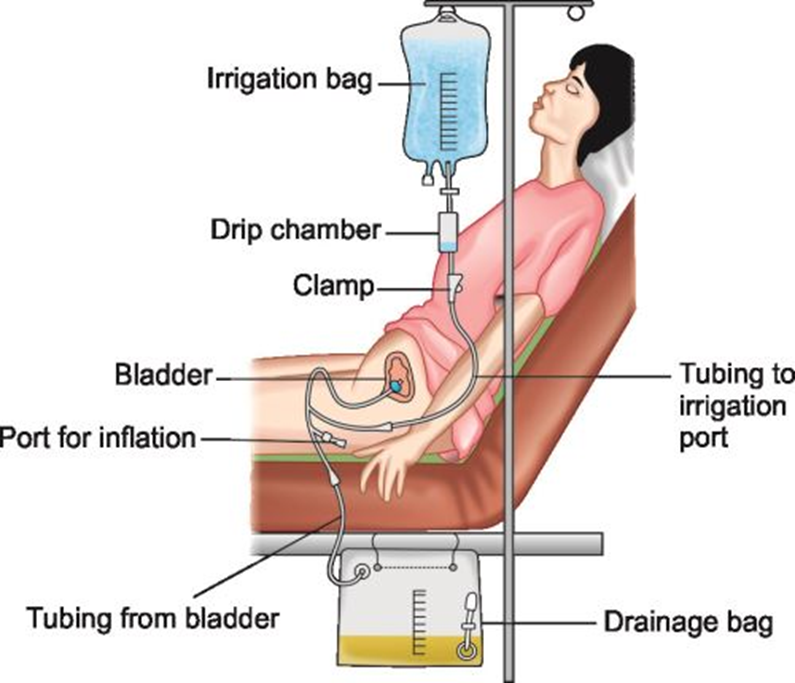A nurse is doing hourly rounding and finds a client unresponsive. The nurse is unable to obtain a pulse and the client is not breathing. What intervention would be the priority for this client?
Starting chest compressions
Obtaining a central line
Completing a comprehensive assessment
Providing rescue breathing
The Correct Answer is A
Choice A reason: Starting chest compressions is the priority intervention for a client who is unresponsive, not breathing, and without a pulse. This situation indicates cardiac arrest, and immediate chest compressions are crucial to maintain circulation and oxygen delivery to vital organs. Early initiation of chest compressions improves the chances of survival and neurological outcomes.
Choice B reason: Obtaining a central line is not an immediate priority in the context of cardiac arrest. While central lines are important for administering medications and fluids, the first step in resuscitation is to establish effective chest compressions. Central line placement can be considered after initial resuscitation efforts are underway.
Choice C reason: Completing a comprehensive assessment is important, but it is not the immediate priority in a cardiac arrest situation. The primary focus should be on initiating chest compressions and basic life support measures. A detailed assessment can be performed once the client is stabilized.
Choice D reason: Providing rescue breathing is part of cardiopulmonary resuscitation (CPR), but it should follow the initiation of chest compressions. Current guidelines emphasize the importance of starting chest compressions immediately and then integrating rescue breaths. Effective chest compressions are the foundation of CPR.
Nursing Test Bank
Naxlex Comprehensive Predictor Exams
Related Questions
Correct Answer is A
Explanation
Choice A Reason:
When calculating the fluid balance for a client undergoing continuous bladder irrigation (CBI), the irrigation solution must be deducted from the total urine output. This is because the irrigation fluid is not part of the client’s actual urine production but is an additional fluid introduced into the bladder to prevent or remove blood clots and ensure catheter patency. By deducting the irrigation solution from the total urine output, the nurse can accurately determine the client’s true urine output and fluid balance.

Choice B Reason:
Subtracting the irrigation solution from the intravenous flow sheet as output is incorrect. The intravenous flow sheet is used to document fluids administered intravenously, not those introduced into the bladder. Therefore, this choice does not apply to the management of continuous bladder irrigation.
Choice C Reason:
Documenting the intake hourly in the urine output column is also incorrect. The urine output column should reflect the actual urine produced by the client, not the irrigation solution. Including the irrigation solution in this column would lead to an inaccurate representation of the client’s urine output and fluid balance.
Choice D Reason:
Adding the irrigation solution to the oral intake column is incorrect as well. The oral intake column is designated for fluids consumed orally by the client. The irrigation solution is introduced directly into the bladder and should not be recorded as oral intake.
Correct Answer is A
Explanation
Choice A reason: Applying compression stockings is a key prophylactic intervention to prevent complications of immobility, such as deep vein thrombosis (DVT) and venous thromboembolism (VTE). Compression stockings help improve blood circulation in the legs by applying graduated pressure, which reduces the risk of blood clots forming in the deep veins. This is particularly important for immobile patients who are at higher risk of developing DVT due to prolonged periods of inactivity.
Choice B reason: Raising all side rails is primarily a safety measure to prevent falls and does not directly address the complications of immobility. While it is important for patient safety, it does not have a significant impact on preventing issues like DVT, pressure ulcers, or muscle atrophy. Therefore, it is not considered a prophylactic intervention for immobility-related complications.
Choice C reason: Inserting a urinary catheter is not a prophylactic intervention for preventing complications of immobility. Catheters are used to manage urinary retention or incontinence but can increase the risk of urinary tract infections (UTIs) if not managed properly. They do not address the primary complications associated with immobility, such as DVT or pressure ulcers.
Choice D reason: Using friction-reducing devices is important for preventing pressure ulcers and skin injuries in immobile patients. These devices help minimize friction and shear forces on the skin, which can lead to pressure ulcers. While this is a valuable intervention, it is not as comprehensive as compression stockings in preventing a range of immobility-related complications.
Whether you are a student looking to ace your exams or a practicing nurse seeking to enhance your expertise , our nursing education contents will empower you with the confidence and competence to make a difference in the lives of patients and become a respected leader in the healthcare field.
Visit Naxlex, invest in your future and unlock endless possibilities with our unparalleled nursing education contents today
Report Wrong Answer on the Current Question
Do you disagree with the answer? If yes, what is your expected answer? Explain.
Kindly be descriptive with the issue you are facing.
